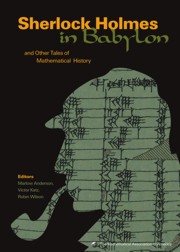Book contents
- Frontmatter
- Introduction
- Contents
- Ancient Mathematics
- Medieval and Renaissance Mathematics
- The Seventeenth Century
- Foreword
- An Application of Geography to Mathematics: History of the Integral of the Secant
- Some Historical Notes on the Cycloid
- Descartes and Problem-Solving
- René Descartes' Curve-Drawing Devices: Experiments in the Relations Between Mechanical Motion and Symbolic Language
- Certain Mathematical Achievements of James Gregory
- The Changing Concept of Change: The Derivative from Fermat to Weierstrass
- The Crooked Made Straight: Roberval and Newton on Tangents
- On the Discovery of the Logarithmic Series and Its Development in England up to Cotes
- Isaac Newton: Man, Myth, and Mathematics
- Reading the Master: Newton and the Birth of Celestial Mechanics
- Newton as an Originator of Polar Coordinates
- Newton's Method for Resolving Affected Equations
- A Contribution of Leibniz to the History of Complex Numbers
- Functions of a Curve: Leibniz's Original Notion of Functions and Its Meaning for the Parabola
- Afterword
- The Eighteenth Century
- Index
- About the Editors
Reading the Master: Newton and the Birth of Celestial Mechanics
from The Seventeenth Century
- Frontmatter
- Introduction
- Contents
- Ancient Mathematics
- Medieval and Renaissance Mathematics
- The Seventeenth Century
- Foreword
- An Application of Geography to Mathematics: History of the Integral of the Secant
- Some Historical Notes on the Cycloid
- Descartes and Problem-Solving
- René Descartes' Curve-Drawing Devices: Experiments in the Relations Between Mechanical Motion and Symbolic Language
- Certain Mathematical Achievements of James Gregory
- The Changing Concept of Change: The Derivative from Fermat to Weierstrass
- The Crooked Made Straight: Roberval and Newton on Tangents
- On the Discovery of the Logarithmic Series and Its Development in England up to Cotes
- Isaac Newton: Man, Myth, and Mathematics
- Reading the Master: Newton and the Birth of Celestial Mechanics
- Newton as an Originator of Polar Coordinates
- Newton's Method for Resolving Affected Equations
- A Contribution of Leibniz to the History of Complex Numbers
- Functions of a Curve: Leibniz's Original Notion of Functions and Its Meaning for the Parabola
- Afterword
- The Eighteenth Century
- Index
- About the Editors
Summary
One factor that has remained constant through all the twists and turns of the history of physical science is the decisive importance of the mathematical imagination.
— Freeman J. DysonIn January of 1684, the young astronomer Edmund Halley travelled from Islington up to London for a meeting of the Royal Society. Later, perhaps over tea and chocolate at a nearby coffee house, he chatted casually about natural philosophy and other topics with Sir Christopher Wren and Robert Hooke. Talk soon turned to celestial motions, and Halley later reconstructed the conversation [22 p. 26]:
I having from the consideration of the sesquialter proportion of Kepler concluded that the centripetall force [to the Sun] decreased in the proportion of the squares of the distances reciprocally, came one Wednesday to town, where I met with Sr Christ. Wren and Mr Hook, and falling in discourse about it, Mr Hook affirmed that upon that principle all the Laws of the celestiall motions were to be demonstrated, and that he himself had done it. I declared the ill success of my attempts; and Sr Christopher to encourage the Inquiry said that he would give Mr Hook or me 2 months time to bring him a convincing demonstration thereof, and besides the honour, he of us that did it, should have from him a present of a book of 40 shillings. Mr Hook then said that he would conceale [his] for some time that other triing and failing, might know how to value it, when he should make it publick.
- Type
- Chapter
- Information
- Sherlock Holmes in BabylonAnd Other Tales of Mathematical History, pp. 261 - 273Publisher: Mathematical Association of AmericaPrint publication year: 2003



